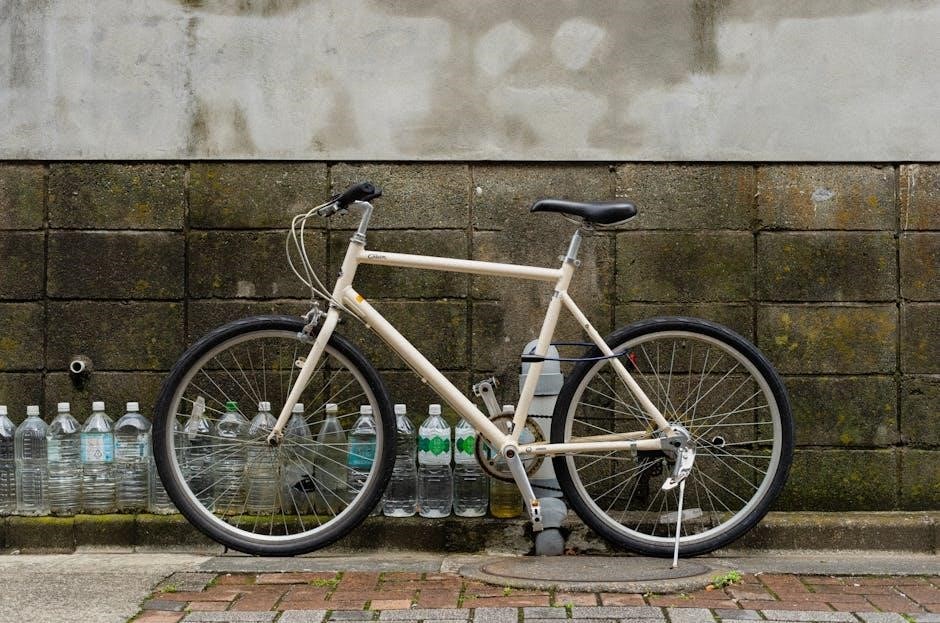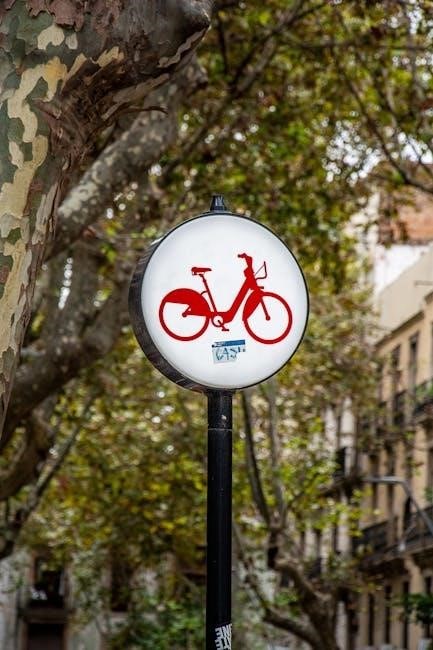Founded in Milan by Edoardo Bianchi in 1885, Bianchi is Italy’s oldest bicycle manufacturer, renowned for its rich heritage, innovative designs, and high-quality craftsmanship․ Bianchi offers a wide range of bicycles, from road to mountain and gravel bikes, each designed with precision to match rider needs․ Proper sizing is crucial for optimal performance and comfort, making a Bianchi bike size guide an essential tool for riders․
1․1․ Brief History of Bianchi
Bianchi, founded in 1885 by Edoardo Bianchi in Milan, Italy, is the oldest bicycle manufacturer in the country․ With a rich heritage spanning over 135 years, Bianchi has been at the forefront of cycling innovation․ The company introduced the first bicycle with equal-sized wheels in 1885, revolutionizing bike design․ Bianchi became synonymous with high-quality craftsmanship and performance, earning a reputation for producing durable, stylish, and innovative bicycles․ Over the years, Bianchi has catered to both professional racers and casual riders, offering a wide range of bikes that combine tradition with modern technology․ Its legacy continues to inspire cyclists worldwide․
1․2․ Why Bike Sizing is Important
Proper bike sizing is essential for comfort, performance, and safety․ A bike that fits your body proportions ensures optimal riding posture, reducing the risk of discomfort or injury․ When a bike is too small or too large, it can lead to inefficient pedaling, poor control, and fatigue․ For Bianchi bikes, sizing is tailored to match rider anatomy, ensuring each model delivers its intended performance․ Whether for road, mountain, or gravel cycling, the right size guarantees a better connection between rider and bike, enhancing overall efficiency and enjoyment․ Bianchi’s size guide helps riders select the perfect fit, making every ride more enjoyable and effective․

Understanding Bianchi Bike Frame Sizes
Bianchi bike frames are sized based on the seat-tube length (A1 measurement)․ Proper sizing ensures optimal fit, performance, and comfort, with stand-over clearance being a key factor․
2․1․ How Bianchi Measures Frame Sizes
Bianchi measures frame sizes using the seat-tube length, specifically the A1 measurement, which is taken from the center of the bottom bracket to the top of the seat tube․ This measurement is crucial for determining the correct frame size․ Bianchi bikes are sized based on this A1 measurement, ensuring a consistent and reliable method for fitting riders․ Additionally, Bianchi considers stand-over clearance, which is the space between the rider and the top tube, to ensure safety and comfort․ While the A1 measurement is the primary factor, other dimensions like top tube length and head tube height also play a role in the overall fit․
2․2․ Differences in Frame Sizes for Road vs․ Mountain Bikes
Frame sizes for Bianchi road bikes and mountain bikes differ significantly due to their distinct geometries and riding purposes․ Road bikes are designed for speed and efficiency, featuring longer top tubes, shorter head tubes, and steeper angles for an aerodynamic position․ Mountain bikes, however, prioritize durability and maneuverability, with shorter top tubes, slacker head tube angles, and higher stand-over clearance to accommodate rough terrain and suspension systems․ Bianchi adapts these geometries to ensure optimal fit and performance for each discipline, making it essential to use the appropriate size chart for either road or mountain bikes when selecting your Bianchi․
2․3․ The Importance of Stand-Over Clearance
Stand-over clearance is a critical factor in bike sizing, representing the space between the rider’s inseam and the top tube of the bike․ This measurement ensures safety, particularly when dismounting quickly, as it prevents injuries from impacting the frame․ Bianchi bikes are designed to provide adequate stand-over clearance, which varies by bike type․ For road bikes, a smaller clearance is acceptable due to smoother terrain, while mountain bikes require more to accommodate rough landings and obstacles․ Proper stand-over clearance enhances both safety and riding confidence, making it a key consideration in the Bianchi bike size guide․

Key Measurements for Bike Sizing
Key measurements include seat tube length, top tube length, and head tube length․ These dimensions ensure proper fit, comfort, and optimal performance for Bianchi bikes․
3․1․ Seat Tube Length (A1 Measurement)
The seat tube length, or A1 measurement, is a critical factor in determining the correct Bianchi bike size․ It is measured from the center of the bottom bracket to the top of the seat tube․ This measurement directly impacts the stand-over clearance and saddle height, ensuring proper fit and comfort․ Bianchi uses the A1 measurement as a key reference point in their size charts, helping riders choose the right frame size․ By consulting the Bianchi bike size guide, riders can match their height and inseam to the appropriate A1 measurement, ensuring optimal comfort and performance on the road or trail․
3;2․ Top Tube Length and Its Impact on Fit
The top tube length plays a significant role in determining the fit and comfort of a Bianchi bike․ It measures the distance between the seat tube and the head tube, influencing the rider’s reach and overall riding position․ A longer top tube can increase reach, potentially improving efficiency for taller riders, while a shorter length suits those with a more compact upper body․ Proper top tube length ensures optimal ergonomics, preventing strain on the back and shoulders․ Riders should consider their handlebar size and stem length in conjunction with the top tube to achieve a balanced and comfortable riding posture․ Testing different sizes is recommended for the best fit․
3․3․ Head Tube Length and Handling
The head tube length significantly influences a bike’s handling and rider comfort․ A longer head tube raises the front end, reducing strain on the neck and shoulders, while a shorter one lowers the bike’s center of gravity, enhancing aerodynamics․ Bianchi bikes often feature varied head tube lengths across sizes to maintain optimal geometry․ For road bikes, a taller head tube improves comfort during long rides, whereas a shorter one is preferred for racing to reduce wind resistance․ Proper head tube length ensures the handlebars are at a comfortable height, allowing precise control and stability․ This measurement, combined with stem length and handlebar height, determines the overall fit and responsiveness of the bike․ Adjustments should align with the rider’s preferred riding style and terrain․

How to Measure Yourself for a Bianchi Bike
Accurate self-measurement is crucial for a proper bike fit․ Measure height, inseam, arm span, and torso length to determine the ideal Bianchi bike size for your body․
4․1․ Measuring Your Height Accurately
To measure your height accurately, stand straight against a wall with your feet flat on the floor and shoulders relaxed․ Remove your shoes and ensure the top of your head is level․ Use a measuring tape or ruler to mark the wall at the highest point of your head․ Measure this distance in centimeters for precision․ Record the measurement carefully, as accurate height is essential for determining the correct Bianchi bike size․ Repeat the process to ensure consistency, and always maintain the same posture during measurement for reliable results․
4․2․ Calculating Your Inseam
To calculate your inseam, stand against a wall with your feet flat on the floor, about 15-20 cm apart․ Place a sturdy object like a book or ruler between your legs, pressing it firmly into your groin area․ Ensure the object is level and parallel to the floor․ Mark the wall at the top edge of the object․ Measure this distance in centimeters, which represents your inseam․ This measurement is crucial for determining stand-over clearance and saddle height on your Bianchi bike․ Accurate inseam measurement ensures proper fit and comfort while riding․ Repeat the process to confirm consistency for reliable results․
4․3․ Measuring Your Arm Span and Torso Length
To measure your arm span, stand straight with your arms extended sideways at shoulder height․ Have someone measure the distance from fingertip to fingertip using a flexible tape measure․ For torso length, sit upright on a chair and measure from the base of your neck (C7 vertebra) to the base of your lower back․ These measurements help determine handlebar size and reach․ A longer arm span may require a wider handlebar, while torso length influences handlebar height and stem length․ Accurate measurements ensure optimal bike fit, improving comfort and control while riding your Bianchi bike․ This step is vital for achieving a comfortable riding position․

Bianchi Bike Size Charts
Bianchi provides detailed size charts for road, mountain, gravel, and urban bikes, based on height and inseam measurements․ These charts offer guidelines to help riders choose the optimal bike size, ensuring comfort and performance․ While the charts are helpful, personal fit preferences may vary, so test rides are recommended for accuracy․
5․1․ Size Chart for Road Bikes
Bianchi’s road bike size chart is tailored to provide precise fit recommendations based on height and inseam measurements․ The chart categorizes frame sizes from 47cm to 61cm, ensuring riders of all statures can find a suitable bike․ Each size corresponds to specific dimensions, such as seat tube length (A1 measurement) and stand-over clearance, to maximize comfort and efficiency․ For instance, a rider measuring 184cm with a 32″ inseam may fit a 57cm or 59cm frame․ While the chart serves as a reliable guide, personal fit preferences can vary, making test rides highly recommended for confirming the best fit․
5․2․ Size Chart for Mountain Bikes
Bianchi’s mountain bike size chart offers a range of frame sizes, typically from 15″ to 21″, designed to accommodate riders of varying heights and inseam lengths․ The chart guides riders in selecting the appropriate size based on their measurements, ensuring optimal stand-over clearance and a comfortable riding position․ For instance, a rider measuring 180cm with a 32″ inseam might fit a 19″ frame․ Unlike road bikes, mountain bike sizing emphasizes stability and control, with frames tailored to handle diverse terrain․ While the chart provides a solid starting point, personal preference and riding style may influence the final choice, making a test ride highly recommended․
5․3․ Size Chart for Gravel and Urban Bikes
Bianchi’s gravel and urban bikes feature size charts tailored for versatility, offering frames from 15″ to 21″ to suit diverse rider heights and inseam lengths․ These bikes blend on-road efficiency with off-road capability, making sizing crucial for comfort and control․ The charts guide riders based on height and inseam, ensuring proper stand-over clearance and a comfortable riding position․ For example, a rider measuring 175cm with a 30″ inseam might fit a 17″ frame․ While the charts provide a baseline, individual preferences for handlebar reach and saddle height may vary, making a test ride essential for optimal fit and performance․

Understanding Bike Geometry
Bike geometry refers to the measurements and angles of a bicycle frame, impacting handling and comfort․ Bianchi’s designs optimize these elements for various riding styles and preferences․
6․1․ Basics of Bike Geometry
Bike geometry refers to the measurements and angles of a bicycle’s frame, which influence its handling, comfort, and performance․ Key elements include head tube angle, seat tube angle, top tube length, and chainstay length․ The head tube angle affects steering responsiveness, while the seat tube angle impacts pedaling efficiency․ Top tube length determines reach and comfort, and chainstay length influences stability and maneuverability․ Understanding these basics helps riders choose a bike that suits their riding style and preferences․ Bianchi bikes are designed with precise geometry to optimize performance across different bike types, ensuring a balanced ride for both comfort and efficiency․
6․2․ Geometry Differences in Bianchi Road Bikes
Bianchi road bikes are designed with specific geometric features to enhance performance and comfort․ The head tube angle is typically steeper, providing responsive handling for aggressive racing positions․ A slightly longer top tube and optimized seat tube angle ensure efficient power transfer and aerodynamic positioning․ Bianchi’s road bikes often feature shorter chainstays for improved acceleration and sharper cornering․ These geometric adjustments make Bianchi road bikes ideal for both professional racers and enthusiast riders seeking a balance of speed, stability, and comfort․ The tailored geometry ensures that each bike size aligns with rider proportions, delivering a seamless and efficient riding experience․
6․3․ Geometry Differences in Bianchi Mountain Bikes
Bianchi mountain bikes are designed for durability and off-road performance, with geometry tailored to handle rough terrain․ A relaxed head tube angle provides stability at high speeds, while a longer wheelbase enhances control on technical trails․ The chainstay length is optimized for maneuverability, allowing sharp turns and easy lifting of the bike’s front end․ Bianchi mountain bikes also feature a lower stand-over height for better clearance and control when dismounting․ The seat tube angle is designed to maintain efficient pedaling even on steep climbs․ These geometric adjustments ensure Bianchi mountain bikes deliver confidence-inspiring handling and responsiveness for riders tackling diverse off-road conditions․
6․4․ Geometry Differences in Bianchi Gravel Bikes
Bianchi gravel bikes are designed to blend the speed of road bikes with the versatility of mountain bikes․ Their geometry features a relaxed head tube angle for stability on uneven surfaces and a longer wheelbase for improved traction and control․ The top tube length is optimized for a more upright riding position, reducing strain on the shoulders and neck during long rides․ A lower bottom bracket drop enhances cornering confidence, while a slightly slacker seat tube angle allows for a more comfortable pedaling position on mixed terrain․ These geometric adjustments make Bianchi gravel bikes ideal for adventures that transition seamlessly between paved roads and off-road trails․

Factors Influencing Bike Fit
Handlebar size, saddle height, cleat position, stand-over clearance, and bike geometry are key factors influencing bike fit, ensuring comfort, efficiency, and control for riders of all levels․
7․1․ Handlebar Size and Reach
Handlebar size and reach significantly impact rider comfort and efficiency․ Wider handlebars provide better control, especially for mountain biking, while narrower bars suit road bikes for aerodynamics․ Reach, the distance from the saddle to the handlebars, affects posture and breathing․ A proper fit ensures your arms aren’t too stretched or cramped, reducing strain․ Measure your arm span and compare it to the handlebar width for optimal sizing․ For Bianchi bikes, handlebar reach is tailored to frame size, ensuring a balanced position․ Test riding with different handlebar configurations helps determine the ideal setup for your riding style and body proportions, enhancing overall performance and comfort․
7․2․ Saddle Height and Position
Saddle height and position are critical for comfort, efficiency, and pedaling performance․ Proper saddle height ensures a slight bend in the knee when the pedal is at its lowest point, typically around 80-90% of leg extension․ To measure, place the pedal at the 6 o’clock position and measure the distance from the saddle top to the pedal spindle․ Bianchi recommends using their size charts as a starting point, then fine-tuning based on personal preference․ The saddle should also be centered horizontally to ensure even weight distribution․ Adjusting the saddle position can improve comfort and reduce strain on the lower back and shoulders during long rides․ Always test saddle height and position during a test ride to ensure optimal fit․
7․3․ Cleat Position and Pedaling Efficiency
Cleat position significantly impacts pedaling efficiency and comfort․ Properly aligned cleats ensure the ball of the foot is over the pedal spindle, optimizing power transfer and reducing strain on the knees․ Incorrect positioning can lead to inefficiency or discomfort․ For Bianchi bikes, start by centering the cleats on the shoe, then adjust based on riding style․ Experienced riders may prefer a more rearward position for efficiency, while newcomers might opt for a slightly forward position for comfort․ Regularly test and adjust cleat placement during rides to ensure optimal performance and prevent fatigue or injury․

Advanced Topics in Bike Sizing
Exploring stack and reach measurements, understanding bike geometry nuances, and advanced fitting techniques ensure a tailored riding experience for performance and comfort․
8․1․ Understanding Stack and Reach Measurements
Stack and reach are critical measurements in bike sizing, determining a bike’s frontal area and rider comfort․ Stack refers to the vertical distance from the bottom bracket to the top of the head tube, while reach measures the horizontal distance from the bottom bracket to the head tube․ Together, these measurements influence a rider’s position, aerodynamics, and handling․ For Bianchi bikes, these dimensions vary across models, ensuring optimal fit for different riding styles․ Proper stack and reach alignment is essential for efficiency and comfort, making them vital considerations in advanced bike sizing and customization․
8․2․ How to Adjust Your Bike for Optimal Fit
Adjusting your Bianchi bike for optimal fit involves fine-tuning key components to match your body and riding style․ Start by ensuring the handlebars are at a height that allows a slight bend in your elbows, promoting comfort and control․ Saddle height should be set so your leg is nearly fully extended at the pedal’s lowest point, with a slight knee bend to avoid strain․ Cleat position on your shoes can be adjusted for optimal pedaling efficiency and comfort․ Additionally, stem length and angle can be modified to achieve the perfect reach and posture․ Regular adjustments and professional bike fittings can further enhance your riding experience․

A Guide for First-Time Bike Buyers
For first-time buyers, ensure the frame size meets stand-over, reach, and seat height requirements․ Test riding and professional fitting are crucial for comfort and performance․
9․1; What to Look for in Your First Bianchi Bike
When selecting your first Bianchi bike, prioritize frame size, comfort, and functionality․ Ensure the bike aligns with your riding style—whether road, mountain, or gravel․ Check the stand-over clearance, seat height, and reach to guarantee a proper fit․ Test ride the bike to assess handling and comfort․ Consider the components, such as brakes and gears, which should suit your riding terrain․ A professional bike fitting can enhance performance and reduce discomfort․ Additionally, review the size chart specific to your bike type to make an informed decision․ Bianchi’s heritage ensures quality, making it a reliable choice for beginners․
9․2․ Tips for Test Riding a Bianchi Bike
Test riding a Bianchi bike is essential to ensure the perfect fit and performance․ Start by choosing a quiet, low-traffic area to familiarize yourself with the bike․ Wear appropriate cycling gear, including shoes and a helmet, for safety․ Begin with a short ride to assess comfort, handling, and responsiveness․ Pay attention to how the bike feels during acceleration, braking, and cornering․ Adjust the saddle height and handlebars if needed to optimize your position․ Test the bike on different terrains to gauge its versatility․ Finally, compare how the bike feels compared to your expectations and previous rides to make an informed decision․

Maintaining the Perfect Fit
Regular bike maintenance checks ensure optimal performance and comfort․ Adjust your bike as your fitness level or riding style changes to maintain the perfect fit․
10․1․ Regular Bike Maintenance Checks
Regular bike maintenance is essential to ensure your Bianchi bike continues to fit perfectly and perform optimally․ Start by checking the brakes, gears, and tire pressure, as these directly impact your riding experience and safety․ Lubricate moving parts, such as the chain and derailleurs, to prevent wear and tear․ Inspect the frame for any damage or scratches and address them promptly to avoid structural issues․ Additionally, ensure the stand-over clearance remains consistent, as changes in tire size or suspension can alter the fit․ Finally, test ride your bike regularly to identify any adjustments needed, such as saddle height or handlebar alignment, to maintain comfort and efficiency․
10․2․ Adjusting Your Bike as Your Fitness Level Changes
As your fitness level improves, your body may undergo changes that affect how your Bianchi bike fits․ For instance, increased flexibility or strength might allow for a more aggressive riding position․ Regularly assess your bike setup to ensure it aligns with your current physique․ Adjustments such as raising the saddle height, tilting the saddle, or altering handlebar reach can enhance comfort and efficiency․ Additionally, as your endurance grows, you might prefer a different gear ratio or tire pressure to optimize performance․ Test ride your bike after making adjustments to confirm the changes feel right․ Consulting a professional fitter can also help fine-tune your setup for peak performance and comfort․
Choosing the right Bianchi bike size ensures optimal performance and comfort․ By following this guide, riders can make informed decisions tailored to their unique needs and preferences․
11․1․ Final Tips for Choosing the Right Bianchi Bike
When selecting your Bianchi bike, prioritize your riding style and terrain․ Ensure proper sizing by consulting Bianchi’s size chart and considering stand-over clearance․ Test riding is crucial to confirm comfort and fit․ Adjust handlebars and saddle height for optimal ergonomics․ Seek professional advice to fine-tune your setup․ Remember, the right bike size enhances performance, comfort, and overall riding enjoyment․ By following these guidelines, you’ll find the perfect Bianchi bike tailored to your needs․
11․2․ The Importance of Proper Bike Fit for Performance and Comfort
Proper bike fit is essential for maximizing performance, comfort, and overall riding enjoyment․ A well-fitted Bianchi bike ensures efficient power transfer, optimal handling, and reduced fatigue․ Incorrect sizing can lead to discomfort, poor posture, and even injuries․ Stand-over clearance, seat height, and handlebar reach are critical factors to consider․ A bike that fits your body proportions allows for better control and endurance․ Regular adjustments as your fitness level or riding style evolves are key to maintaining optimal fit․ Prioritizing proper bike fit ensures a safer, more enjoyable, and higher-performance riding experience, making every mile on your Bianchi bike a pleasure․
